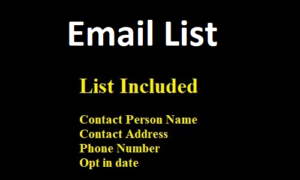Email is a widely used communication tool in both personal and professional settings. However, most email providers impose limitations on email data to ensure efficient use of resources and prevent abuse. This article explores the concept of email data limits, focusing on attachment size restrictions and email storage capacity.
Attachment Size Restrictions:
Heading 1: Understanding File Size Limits
One of the most common email data limits relates to the size of attachments that can be sent with an email. Each email provider sets specific attachment size restrictions, which can vary from a few megabytes to a few gigabytes. When attaching files that exceed the Japan Email list specified limit. The email may fail to send or result in bounced messages.
Attachment size restrictions exist because large attachments can strain email servers, slow down email delivery, and lead to storage capacity issues. To overcome this limitation, users can use cloud storage services to share large files and include download links in their emails.
Email Storage Capacity:
Heading 2: Managing Inbox and Sent Items
Another critical aspect of email data limits is the storage capacity for individual email accounts. Email providers allocate a certain amount of storage space to each user, which includes the combined space for inbox, sent items, and other folders.
As users send and receive emails, store attachments, and retain messages, their email storage usage increases. When the storage capacity reaches its limit, users may experience issues such as being unable to receive new emails or send outgoing messages.
To manage email storage effectively, users can regularly delete unnecessary emails, archive old messages, and empty the trash or deleted items folder. Archiving important emails to local storage or cloud storage can also free up space without permanently losing valuable data.
Importance of Regular Data Cleanup:
Heading 3: Avoiding Overloaded Email Accounts
Regular data cleanup is crucial to prevent email accounts from becoming overloaded with unnecessary data. By removing redundant emails and attachments, users can ensure that their email B2B Lead accounts have enough storage space to operate smoothly.
Keeping the inbox organized and periodically cleaning out old or irrelevant messages can also improve email efficiency and help users find important emails more easily.
Conclusion:
Understanding email data limits, including attachment size restrictions and email storage capacity, is essential for efficient email communication. Users should be mindful of attachment sizes to avoid delivery issues and consider alternative methods for sharing large files.







